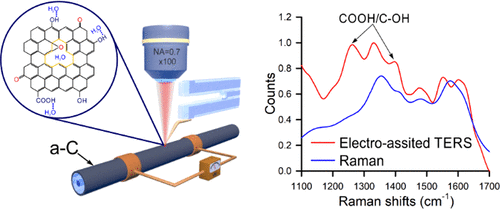当前位置:
X-MOL 学术
›
J. Phys. Chem. C
›
论文详情
Our official English website, www.x-mol.net, welcomes your feedback! (Note: you will need to create a separate account there.)
Water-Anchored Edge Defects in Amorphous Carbon Probed with Thermal- and Electroassisted Raman Spectroscopy and Nanoscopy
The Journal of Physical Chemistry C ( IF 3.7 ) Pub Date : 2020-06-30 , DOI: 10.1021/acs.jpcc.0c03143 Sergey S. Kharintsev 1 , Svetlana V. Saparina 1 , Alexandr I. Fishman 1 , Andrei A. Stolov 2 , Jie Li 2
The Journal of Physical Chemistry C ( IF 3.7 ) Pub Date : 2020-06-30 , DOI: 10.1021/acs.jpcc.0c03143 Sergey S. Kharintsev 1 , Svetlana V. Saparina 1 , Alexandr I. Fishman 1 , Andrei A. Stolov 2 , Jie Li 2
Affiliation

|
As-thermal-CVD-synthesized amorphous carbon (a-C) ultrathin coatings enable silica optical fibers to be mechanically robust and optically transparent in aggressive environments. This is achieved by mitigating both hydrogen diffusion and water ingression onto the fiber surface. Notwithstanding the advanced performance of CVD-deposited a-C films, their functionality may suffer from structural and topology defects, dopants, intrinsic stresses, and other imperfections. In this paper, we experimentally study the influence of water-anchored edge functional groups on dc electrical conductivity and Raman scattering of a-C films, ranging from 10 to 100 nm in thickness, exposed to thermal and electrical annealing. A series of heating/cooling cycles was found to affect the disorder D-family bands in the Raman spectra of a-C. In particular, two new Raman peaks at 1260 and 1400 cm–1, attributed to carboxyl (COOH) and hydroxyl (C–OH) groups, have been unraveled through polarization-controlled far-field Raman spectroscopy and tip-enhanced Raman scattering (TERS) spectroscopy. The TERS technique allows one to readily resolve the broad disorder D-family bands due to the excitation of coherent Raman scatters (nanosized graphitic clusters). A temperature-sensitive and thickness-dependent hysteresis in dc conductivity, observed at temperatures of above 80 °C, is explained by physical sorption/desorption of water at the surface of graphite-like crystals through hydrogen bonding and dissociative absorption of water with the formation of extra COOH/C–OH groups at the edge defects. The electroheating leads to a nonuniform distribution of the water-decorated edges owing to hot spots of a percolated carbon crystals network. This is directly evidenced by electroassisted TERS mapping of the a-C coating. We believe that our study will pave a way for the understanding of how water interacts with amorphous carbon and improve the performance of carbon coatings in harsh environments.
中文翻译:

用热和电辅助拉曼光谱和纳米技术探测非晶碳中水锚定的边缘缺陷
热CVD合成的无定形碳(aC)超薄涂层使二氧化硅光纤在侵蚀性环境中具有机械强度和光学透明性。这是通过减少氢扩散和水浸入纤维表面来实现的。尽管CVD沉积的aC膜具有先进的性能,但其功能可能会受到结构和拓扑缺陷,掺杂剂,固有应力和其他缺陷的影响。在本文中,我们通过实验研究了水锚固的边缘官能团对暴露于热退火和电退火的厚度为10至100 nm的aC膜的直流电导率和拉曼散射的影响。发现一系列加热/冷却循环影响aC的拉曼光谱中的D族无序带。尤其是,–1归因于羧基(COOH)和羟基(C–OH)的碳原子,已通过偏振控制的远场拉曼光谱和尖端增强拉曼散射(TERS)光谱得以阐明。由于相干拉曼散射(纳米石墨簇)的激发,TERS技术使人们能够轻松解决宽泛的D族谱带。在高于80°C的温度下观察到的直流电导率随温度变化且随厚度变化的磁滞现象,是通过水样在石墨状晶体表面通过氢键的物理吸附/解吸和水与地层的解离吸收来解释的边缘缺陷处有多余的COOH / C-OH基团。由于渗透的碳晶体网络的热点,电加热导致水装饰边缘的分布不均匀。aC涂层的电辅助TERS映射直接证明了这一点。我们相信我们的研究将为理解水如何与无定形碳相互作用以及改善在恶劣环境下碳涂层的性能铺平道路。
更新日期:2020-07-23
中文翻译:

用热和电辅助拉曼光谱和纳米技术探测非晶碳中水锚定的边缘缺陷
热CVD合成的无定形碳(aC)超薄涂层使二氧化硅光纤在侵蚀性环境中具有机械强度和光学透明性。这是通过减少氢扩散和水浸入纤维表面来实现的。尽管CVD沉积的aC膜具有先进的性能,但其功能可能会受到结构和拓扑缺陷,掺杂剂,固有应力和其他缺陷的影响。在本文中,我们通过实验研究了水锚固的边缘官能团对暴露于热退火和电退火的厚度为10至100 nm的aC膜的直流电导率和拉曼散射的影响。发现一系列加热/冷却循环影响aC的拉曼光谱中的D族无序带。尤其是,–1归因于羧基(COOH)和羟基(C–OH)的碳原子,已通过偏振控制的远场拉曼光谱和尖端增强拉曼散射(TERS)光谱得以阐明。由于相干拉曼散射(纳米石墨簇)的激发,TERS技术使人们能够轻松解决宽泛的D族谱带。在高于80°C的温度下观察到的直流电导率随温度变化且随厚度变化的磁滞现象,是通过水样在石墨状晶体表面通过氢键的物理吸附/解吸和水与地层的解离吸收来解释的边缘缺陷处有多余的COOH / C-OH基团。由于渗透的碳晶体网络的热点,电加热导致水装饰边缘的分布不均匀。aC涂层的电辅助TERS映射直接证明了这一点。我们相信我们的研究将为理解水如何与无定形碳相互作用以及改善在恶劣环境下碳涂层的性能铺平道路。



























 京公网安备 11010802027423号
京公网安备 11010802027423号